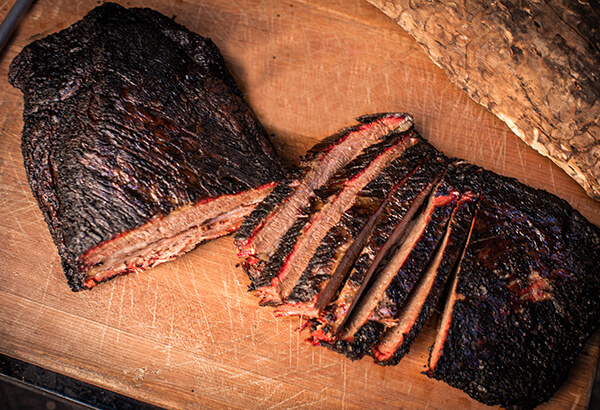How Can You Get BBQ Bark on Your Egg Barbecue Grill?
In this article, I’ll explain what BBQ bark is, how it’s made, and share with you my top tips for achieving this nirvana on your egg barbecue grill, whether it’s charcoal or gas.
The crunchy, sweet, salty, caramelized crust cracks open to reveal a treasure trove of juicy, moist, melt-in-your-mouth pork. I’m drooling thinking about it now!
The secret to this particular barbecue is the bark. When you seal, sear, and smoke meat on the outside, you create two great things: a deliciously dark and complex crust, and soft, moist meat on the inside. This is a big reason why smoked brisket is so delicious.
What is BBQ Bark?
Well done, it’s what gets top marks in the grilling competition: a tough, crunchy, deep and complex crust surrounds a piece of meat, contrasting with the soft and juicy slow-cooked meat inside. A good bark will make you forget your manners and maybe push an older relative away so you can get seconds (or thirds or quarters)!
The core process of bark formation is the Maillard reaction. This is defined as a series of non-enzymatic chemical reactions between carbonyl groups (the main carbohydrate) and amino compounds of biological origin. For those of us who don’t have a Ph.D. In molecular biology, this basically refers to the process of browning!
Take the ingredients and heat, let the natural sugars and proteins do their job, and you’ll get enhanced, deep, complex flavors.
Ever seen raw coffee beans? It’s a wimpy, soft, pale seed that you’ll never believe is the same thing that gets your butt going with its strong smell every morning. This is the Maillard reaction.
For meat, the magic is just as powerful, turning raw meat and even tough meat fibers into a juicy, flavorful bite with a delicious dark mahogany crust.
Check out this great short video that shows up close and personal what BBQ bark is. (Warning: will make you hungry!)
How Is the Bark Formed?
It’s the result of a series of complex chemical reactions, but luckily it’s not complicated to make! The simple answer is that when you combine the following factors in the right way, you get bark:
•Sugar and salt based spice rub
•Smokes
•Water vapor
•Low temperature
Let’s take a closer look at each of these factors.
Spice Rub
This is your starting point, you can add anything you like, except sugar and salt are the backbone of a good bark rub.
Classic spice rubs usually include paprika and pepper. But chili, onion powder, garlic powder, and ginger are other popular rubbing ingredients that affect the taste and consistency of the final product (bark). Heavy spice rubs are usually thicker than mostly salt based rubs.
Sugar is a tricky thing to do with grilling. At high heat, sugar is known to burn quickly, leaving behind a bitter, charred meat. But since smoking is done at lower temperatures (usually below 300°F), you shouldn’t have a problem with sugar in your rubs. Some people still recommend that beginners add sugar at the end of smoking for safety.
Smokes
After rubbing, smoke is the next most important factor in getting a good bark. Over time, smoke particles adhere to the surface of the meat, merge with the spice, darken in color, and infuse a deep licorice sweetness that we can’t get enough of.
The longer the meat is smoked, the darker it becomes, until it is almost black but not burnt.
Water Vapor
As the seasoned meat heats, it releases moisture. This, along with the water vapor in the smoke, dissolves the water-soluble components of the meat…especially the salt, which is then absorbed into the meat for deep seasoning.
Other spice ingredients are too large to penetrate the meat, but will dissolve in the surface fat and flavor the surface of the meat.
Temperature
As with everything related to grilling, temperature is key.
Meat that is too cold will not peel, and meat that is too hot will burn. So what’s the sweet spot?
Around 225°F is recommended as the ideal temperature for smokers. But since grills and smokers have their own personalities and quirks, you may need to experiment a bit in the 200-300° F range to get to your own Goldilocks temperature (just right!) for smoking large bark.
How Does Fat Affect Bark Formation?
Fat — how much and what kind — is often an important part of the grilling process, contributing to the flavor, tenderness and juiciness of the meat. But you might be surprised to learn that large amounts of fat are not necessary for bark to form.
All meats, even lean ones, will have some fat, which helps moisturise the meat and attach to fat-soluble spices as it melts during the grilling process.
But studies have shown that even a lack of the amount of fat on a piece of meat does not affect the formation of good bark. In fact, excess fat is not recommended, so if your joint has a large fat cap, cut most of it off. (Especially good suggestion for a brisket or a big fat cap on a Boston butt.)
A Little Science About Bark
We’ve discussed starting with a good spice rub. But the real magic starts when you add heat and smoke. The first thing that happens is that the meat releases moisture, which mixes with the water vapor in the smoke, dissolving the salt, sugar, and water-soluble flavors. The fat then begins to melt and rise to the surface to dissolve the fat-soluble spices and form a tough paste-like glaze, which is the beginning of the bark, in the form of spice bark.
As the heat increases and time passes, the moisture evaporates and the meat starts to dry out. At this point, the surface proteins begin to bind together to form polymers, which will bake into a hardened layer (the pellicle, AKA bark).
But there is more to do. In fact, whenever you heat up in cooking, a whole bunch of chemical reactions kick in at the same time. On a piece of smoking meat, the sugar in the rub begins to react with the protein to brown and caramelize, thanks to the presentation of surface fat (Maillard reaction).
As the meat goes through these chemical transformations, smoke particles attach to the surface paste, further enhancing the flavor complexity and turning the color into a deep ebony color.
I tell you, it will only get better. In fact, it’s the smoke that gives the bark its characteristic deep licorice lacquer color. It looks like it’s on fire, but it’s not.
Which Meats Are Best for Getting Good Bark?
The good news is that you don’t have to spend a fortune on meat, which produces great bark.
Big, cheap cuts with a long smoke, are your friends: pork shoulder or butt (pulled pork), brisket and ribs all produce wonderful bark when rubbed with delicious spices and long smoke.
8 Top Tips for Getting Good Bark
1. Make sure your meat is nice and dry. Gently pat with a tissue before applying.
2. Seek maximum surface area. More canvas for your rubbing work equals tastier bark! Cut the large, thick joint in half and use a sharp knife to make a ½” deep cut in it so you can get the rub into the meat.
3. Fix yourself a dry wipe, but don’t feel the need to be fancy! Some of the best bark is made with just salt and sugar (like the bo ssam I eat). Everything is technical. Check out this guide for a good brisket rub recipe for maximum bark.
4. Make sure there is good airflow around the meat for the bark to form. There are no trays here. It is best to place the meat directly on the grate. You can always add a drip tray underneath to collect juices and prevent flare-ups.
5. Do not wrap meat in foil during cooking (Texas cane method). While this is usually a good way to push the cook through the stall, caused by evaporative moisture cooling and slowing the cook, in this case it creates too much moisture and interferes with bark formation. You can use pink butcher paper as a good medium option, but the best bark comes from no packaging.
6. For the same reason, don’t grease the meat. The moisture and fat in the meat and the water vapor in the smoke are enough to keep the meat juicy and juicy. Also, you want the meat to dry out on the outside, and the oiling will continue to moisten and break down the bark that’s forming. Some mop sauces are exceptions here, as described in our article, What is Mop Sauce.
7. Remove most of the fat cap and any other visible thick fat. You want to keep a thin layer of fat, but its bulk will interfere with film formation.
8. Smoke fat cap down. The melted fat washes off the meat and can wash away some of the friction and smoke particles that are necessary for good bark to form. Liposuction often has other benefits as well (depending on your type of smoker.)
9. Cook slowly. There is no rush of good bark and no rush of bark. According to our chart on cooking time for smoke, you will need 10-12 hours at around 220°F. But hey, spending the day hanging out with a smoker is an excellent antidote to the frantic pace of life. In fact, it could be a great way to lower your blood pressure!
In This Case, The Bark is as Good as the Bite
Getting nice bark on your brisket or pork shoulder can take some practice. The ingredients are simple, but there is so much complex chemistry brewing in your smoker that it can take a few tries to master.
So why are we having all this trouble?
Because the first bite, from the grilled tangy crust to the sweet soft meat underneath, is an otherworldly experience for foodies like you and me. Plus, half the fun of grilling is experimenting. So give it a try and let us know how it works for you.

